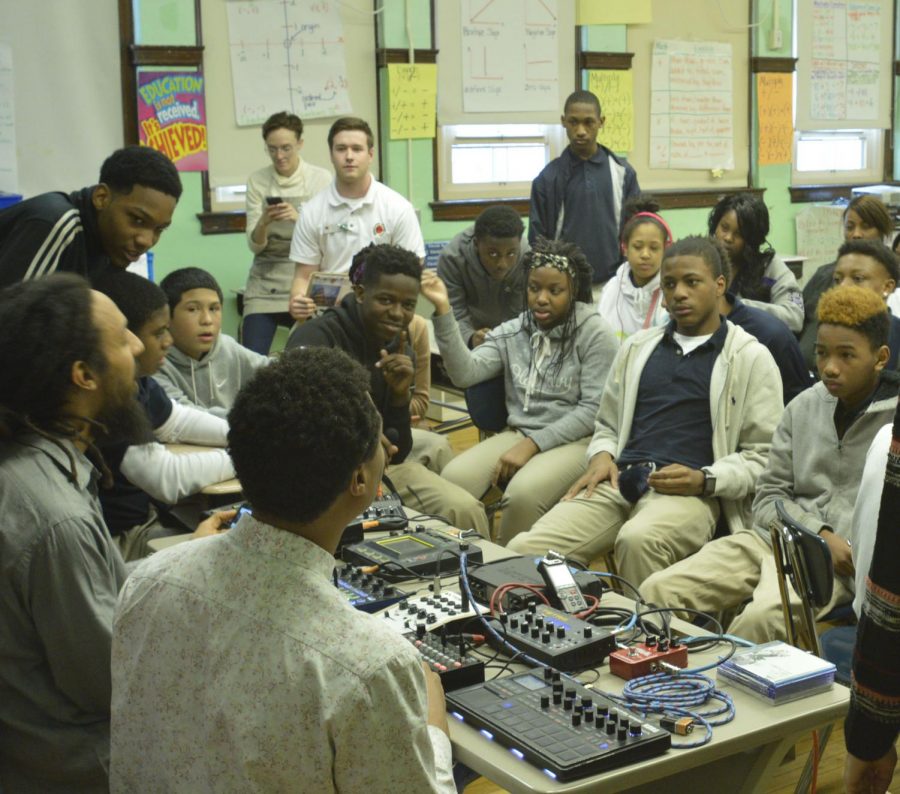Do-re-MeMa: program mixes music, activism to teach history
The Motivate & Encourage Music Appreciation program at Stone Academy has now expanded to Langford Community Academy on the South Side.
March 13, 2017
Instead of cracking open textbooks for their next history lesson, students are writing original melodies and lyrics to tackle the past.
The Motivate & Encourage Music Appreciation program has been teaching children about everything from the Vietnam War to the Civil Rights Movement through music for the past five years at Stone Academy in West Rogers Park. In February, the program expanded to the South Side at Langford Community Academy.
The program was created to inspire and teach students social studies through music and performance, according to MeMa Founder Jeanne Warsaw-Gazga.
“Most kids are bored to death [with social studies],” Warsaw-Gazga said. “I have seen students that are on the spectrum [of learning disabilities] come alive [in the program]. Students that are typically bored and never pay attention start to pay attention.”
The program typically lasts eight weeks, with a showcase at the end at which eighth and ninth grade students present projects on topics they choose. These projects can include anything from musical and spoken word performances to interviews and films. The program focuses on the political movements of the ‘60s and ‘70s, but they are intertwined with political issues of today, Warsaw-Gazga said.
“Growing up in the mid-to-late ‘60s, I was lucky enough to hear a lot of the social protests, rock music, and then in the ‘70s, a lot of the socio-political music a lot of the R&B artists were making,” Warsaw-Gazga said. “I loved that this music was a way to bring people together and to work for a better cause.”
Warsaw-Gazga got the idea from 25 years of experience working in the music industry. She said she wanted to make music with kids and share the different emotions music brings up. Because she was particularly interested in the Vietnam War and the music that came out of that era, the idea seamlessly fit into a social studies class setting, she added.
Edward Patock, a teacher at Stone Academy, said Warsaw-Gazga brings in artists to teach students about subjects they are passionate about. The students not only learn information, but also gain experience and find out they can excel in areas such as songwriting or drawing, he added.
“This is something that [we] at [Chicago Public Schools], with our vast funding sources, cannot even hope to match,” Patock said.
Lisa Giddens-White, whose daughter participated in the program last May, praised the program for tapping into the intersection of music and history and making it accessible for kids. One project she recalled was a student interviewing family friends that were older, Vietnamese immigrants on their experiences seeing the Vietnam War unfold.
“It was important to the student and they were able to interview and [research] on the Vietnam War,” Giddens-White said.
Warsaw-Gazga said one of her teaching methods is to use video clips on topics such as income inequality, noting better results for students who learn visually. The video allows them to compare and analyze history over time.
“It’s such a difference when you are visually looking at videos giving you similar information from a textbook,” Warsaw-Gazga said. “Today’s students are visual. They are always on a computer or phone.”
Teaching students with music promotes literacy and empathy, said Nathan Bakkum, associate professor in the Music Department who teaches music history. The earlier kids are engaged musically, the earlier they think creatively.
“Music is a way of engaging with the world,” Bakkum said. “There are things you can do and say in music that you can’t do and say in any other way.”
The program inspires kids to think creatively while teaching them how to conduct research, Giddens-White said.
“It’s about what’s important to these kids and putting it out [creatively] to reflect their world,” Giddens-White said. “[Kids]connect with history and themselves.”








